Avro 504 Videos
|
Loading...
|
|
Avro 504
Avro 504
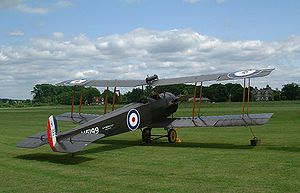
Role: Trainer, Fighter, Bomber
Manufacturer: Avro
First flight: 18 September 1913
Introduced: 1913
Retired: 1934
Primary users: Royal Flying Corps
Royal Naval Air Service
Produced: 1913 - 1932
Number built: 8970
The Avro 504 was a World War I biplane aircraft made by the Avro aircraft company and under licence by others. Production during the War totalled 8,970 and continued for almost 20 years, making it the most-produced aircraft of any kind that served in World War I, in any military capacity, during that conflict. Over 10,000 would be built from 1913 to the time production ended in 1932.
Design and development
First flown on 18 September 1913, powered by an 80 hp (60 kW) Gnome Monosoupape engine, the Avro 504 was a development of the earlier Avro 500, designed for training and private flying. It was a two-bay biplane of all-wooden construction, with a square-section fuselage.
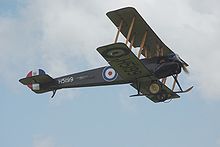
Picture - The Shuttleworth Avro 504K
Operational history
Small numbers of early aircraft were purchased both by the Royal Flying Corps (RFC) and the Royal Naval Air Service (RNAS) prior to the start of World War I, and were taken to France when the war started. One of the RFC aircraft was the first British aircraft to be shot down by the Germans, on 22 August 1914. The pilot was 2nd Lt. Vincent Waterfall and his navigator Lt Charles George Gordon Bayly (both of 5 Sqn RFC) The RNAS used four 504s to form a special flight in order to bomb the Zeppelin works at Friedrichshafen on the shores of Lake Constance. Three set out from Belfort in north-eastern France on 21 November 1914, carrying four 20 lb (9 kg) bombs each. While one aircraft was shot down, the raid was successful, with several direct hits on the airship sheds and destroying the hydrogen plant.
Soon obsolete as a front-line aircraft, it came into its own as a trainer, with thousands being built in the war, with major production types being the 504J and the mass production 504K, which was designed with modified engine bearers to accommodate a range of engines, in order to cope with engine shortages. 8,340 Avro 504s had been produced by the end of 1918.
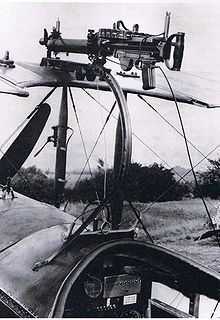
Picture - Foster mounted Lewis gun on night fighter Avro 504K
In the winter of 1917-18, it was decided to use converted 504Js and 504Ks to equip Home Defence squadrons of the RFC, replacing ageing B.E.2cs, which had poor altitude performance. These aircraft were modified as single-seaters, armed with a Lewis gun above the wing on a Foster mounting, and powered by 100 hp (75 kW) Gnome or 110 hp (80 kW) Le Rhx´ne engines. 274 converted Avro 504Js and Ks were issued to eight home defence squadrons in 1918, with 226 still being used as fighters at the end of World War I.
Following the end of the war, while the type continued in service as the standard trainer of the RAF, large numbers of surplus aircraft were available for sale, both for civil and military use. More than 300 504Ks were placed on the civil register in Britain. Being used for training, pleasure flying and banner towing, civil 504s continued flying in large numbers until well into the 1930s.
Although Avro 504s sold to China were training versions, they participated in battles among warlords by acting as bombers with pilot dropping hand grenades and modified mortar shells.
The improved, redesigned and radial engined 504N was produced by Avro in 1925. After evaluation of two prototypes powered by Bristol Lucifer and Armstrong-Siddeley Lynx engines respectively, the Lynx powered aircraft was selected by the RAF to replace the 504K. 592 were built between 1925 and 1932, equipping the RAF's five flying training schools, while also being used as communication aircraft. The 504N was also exported to the militaries of Belgium, Brazil, Chile, Denmark, Greece, Thailand and South Africa, with licenced production taking place in Denmark, Belgium, Canada and Japan.
The 504N was finally replaced in 1933 by the Avro Tutor in RAF service, with small numbers continuing in civilian use until 1940, when seven were impressed into RAF service, where they were used for target- and glider-towing.
The 504 was the first aeroplane to strafe troops on the ground as well as the first to make a bombing raid over Germany. It was also the first Allied aeroplane to be downed by enemy anti-aircraft fire and was Billy Bishop's first army aircraft.
The 504 is easily recognisable because of the single skid between the wheels.
Variants
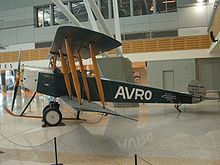
Picture - Qantas Avro 504K replica displayed at Qantas Domestic Terminal
504: 80 hp (60 kW) Gnome engine.
Original model
504A:
Modified with smaller ailerons and broader struts. 80 hp (60 kW) Gnome engine.
504B
Version for RNAS with larger fin. 80 hp (60 kw) Gnome or Le Rhx´ne engine.
504C
Single-seat anti-zeppelin aircraft for the RNAS. The 504C was fitted with an extra fuel tank, in place of the observer.
504D
Single-seat anti-zeppelin aircraft for the Royal Flying Corps. Six built.
504E: 100 hp (75 kW) Gnome engine. Ten built.
504F: 75 hp (60 kW) Rolls-Royce Hawk engine. One built.
504G: 80 hp (60 kW) Gnome engine.
504H
Used for catapult trials. 80 hp (60 kW) Gnome engine.
504J
Used as a trainer. 100 hp (75 kW) Gnome or 80 hp (60 kW) Le Rhx´ne engine.
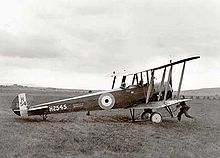
Picture - This Avro 504K was the first aeroplane in Iceland, taken there in 1919
504K
Two-seat training aircraft. The 504K had a universal mount to take different engines. Single-seat fighter conversion used for anti-zeppelin work. Several were assembled in Australia by Australian Aircraft & Engineering. 130 hp (100 kW) Clerget, 100 hp (75 kW) Gnome or 110 hp (80 kW) Le Rhx´ne engines.
504K Mk.II
Hybrid trainer based on 504K fuselage with 504N undercarriage and wings and powered by rotary engine. Built under license in Mexico as Avro Anahuac.
504L
Floatplane version. 150 hp (112 kW) Bentley BR1, 130 hp (100 kW) Clerget or 110 hp (82 kW) Le Rhx´ne engines.
504M
Three-seat cabin biplane. Only one was ever built. 100 hp (75 kW) Gnome engine.
504N
Two-seat training aircraft. Redesigned postwar trainer for RAF with 160 hp (120 kW) Armstrong Siddeley Lynx engine. 598 built.
504O
Floatplane version of 504N. First aircraft to fly above the Arctic Circle in 1923 Oxford Expedition.
504P
Unbuilt version of the 504N with side-by-side seating.
504Q
Three-seat cabin biplane. The 504Q was built for the Oxford University Arctic Expedition. Only one was ever built. Armstrong Siddeley Lynx engine.
504R Gosport
Reworked trainer with revised, lightweight structure. Five prototypes flown 1926 to 1927 with various engines (100 hp/75 kW Gnome Monosoupape, 100 hp/75 kW) Avro Alpha, 140 hp/104 kW Armstrong Siddeley Genet Major and 150 hp/110 kW) Armstrong Siddeley Mongoose), with the Mongoose chosen for production aircraft. Ten were sold to Argentina, with 100 more built by FMA under licence in Argentina. At least six were exported to Estonia, remaining in service until 1940, and an unknown number to Peru.
504S
Two-seat training aircraft. Built under licence in Japan by Nakajima.
Yokosuka K2Y1
Japanese version of the Avro 504N, powered by a 130 hp (100 kW) Mitsubishi-built Armstrong-Siddeley Mongoose radial piston engine, 104 built.
Yokosuka K2Y2
Improved version of the K2Y1, powered by a 160 hp (120 kW) Gasuden Jimpu 2 radial piston engine. 360 built (K2Y1 and K2Y2).
U-1 (Uchebnyi - 1) Avrushka
Russian copy of the 504K. Over 700 built.
MU-1 (Morskoy Uchebnyi - 1)
Russian seaplane version.
Survivors and flyable reproductions
A small number of static display, and airworthy examples of the Avro 504 exist, almost a century after the first one flew, one of the airworthy examples being the Shuttleworth Collection's example -another flyable example exists in a Canadian aviation museum. An Avro 504K can also be found on static display in the Making of the Modern World Gallery at the London Science Museum.
The Old Rhinebeck Aerodrome has had a flyable Avro 504 reproduction aircraft, powered by an original 110 hp Le Rhx´ne rotary engine, flying since 1971, and a newly founded company (Blue Swallow Aircraft) in Virginia is starting to produce reproduction Avro 504 examples.
Operators
Argentina Australia
Australian Flying Corps
No. 5 (Training) Squadron in the United Kingdom
No. 6 (Training) Squadron in the United Kingdom
No. 7 (Training) Squadron in the United Kingdom
No. 8 (Training) Squadron in the United Kingdom
Central Flying School AFC at Point Cook, Victoria
Royal Australian Air Force
No. 1 Flying Traing School RAAF at Point Cook
Western Australian Airways
Belgium
Belgian Air Force purchased 50 British-built 504Ks from 1920-22, with a further 27 being built under license by SABCA These were replaced by the 504N, 17 being built by Avro in 1929-31, and 31 being built under license.
Brazil Canada
Royal Canadian Air Force
Chile China Denmark Estonia
Estonian Air Force
Finland
Finnish Air Force
Greece
Hellenic Air Force
Guatemala British India Iran
Imperial Iranian Air Force
Ireland
Irish Air Service
Irish Air Corps
Japan Federated Malay States Mexico Mongolia
Mongolian People's Army Air Corps
Netherlands
Dutch Army Aviation Group -
Royal Netherlands East Indies Army Air Force
New Zealand
New Zealand Permanent Air Force
Norway
Norwegian Army Air Service
Peru Poland
1 Avro 504K
Portugal
Portuguese Air Force
Portuguese Navy
Russian Empire South Africa
South African Air Force
Soviet Union Kingdom of Spain Sweden
Swedish Air Force
Swedish Navy
Switzerland Siam (Thailand) United Kingdom
Royal Flying Corps
Royal Air Force
Royal Naval Air Service
United States
United States Army Air Service
Uruguay
Specifications (Avro 504K)
Data from The Encyclopedia of World Aircraft
General characteristics
Crew: 2
Length: 29 ft 5 in (8.97 m)
Wingspan: 36 ft (10.97 m)
Height: 10 ft 5 in (3.17 m)
Wing area: 330 ft² (30.7 m²)
Empty weight: 1,231 lb (558 kg)
Max takeoff weight: 1,829 lb (830 kg)
Powerplant: 1x— Le Rhx´ne Rotary, 110 hp (82 kW)
Performance
Maximum speed: 90 mph (145 km/h)
Cruise speed: 75 mph (126 km/h)
Range: 250 mi (402 km)
Service ceiling: 16,000 ft (4,875 m)
Rate of climb: 700 ft/min (3.6 m/s)
Wing loading: 5.54 lb/ft² (18.2 kg/m²)
Power/mass: 0.06 hp/lb (0.099 kW/kg)
Climb to 3,500 ft (1,065 m) in 5 min
Manufacturers
The following companies are recorded as manufacturing the Avro 504 under licence.
A. V. Roe and Co Ltd, Park Works, Newton Heath, Manchester; and at Hamble Aerodrome, near Southampton, Hants.
Australian Aircraft and Engineering Co Ltd, Sydney, NSW, Australia
The Brush Electrical Engineering Co Ltd, Loughborough
Canadian Aeroplanes Ltd, Toronto, Canada
The Eastbourne Aviation Co Ltd, Eastbourne
Fabrica Militar de Aviones, Cordoba, Argentina
Frederick Sage and Co Ltd, Peterborough and London
The Grahame-White Aviation Co Ltd, Hendon Aerodrome, London
Harland and Wolff Ltd, Belfast
The Henderson Scottish Aviation Factory, Aberdeen
Hewlett and Blondeau Ltd, Oak Road, Leagrave, Luton, Bedfordshire.
The Humber Motor Co Ltd, Coventry Morgan and Co, Leighton Buzzard, Beds.
Nakajima Hikoki Seisaku Sho, Ohta-Machi, Tokyo, Japan
Parnall & Sons, Mivart Street, Eastville, Bristol
S. E. Saunders Ltd, East Cowes, Isle of Wight Savages Ltd, King's Lynn,
Societe Anonyme Belge de Constructions Aeronautiques Haren, Brussels, Belgium
The Sunbeam Motor Car Co Ltd, Wolverhampton
TNCA, Balbuena field in Mexico City.
Yokosuka Naval Arsenal, Japan
Related development
La Cierva C-6
Bruce, J.M. (9 July 1954). "The Avro 504: Historic Military Aircraft No. 8, Part I" (pdf). Flight: pp.41-44. http://www.flightglobal.com/pdfarchive/view/1954/1954%20-%201998.html.
Bruce, J.M. (16 July 1954). "The Avro 504: Historic Military Aircraft No. 8, Part II" (pdf). Flight: pp.83-88. http://www.flightglobal.com/pdfarchive/view/1954/1954%20-%202060.html.
Bruce, J. M. (1965). Warplanes of the First World War - Fighter, Volume One, Great Britain. London: Macdonald.
Donald, David (Editor) (1997). The Encyclopedia of World Aircraft. Aerospace Publishing. ISBN 1-85605-375-X.
Holmes, Tony (2005). Jane's Vintage Aircraft Recognition Guide. London: Harper Collins. ISBN 0 0071 9292 4.
Jackson, A.J. (1990). Avro Aircraft since 1908 (Second ed.). London: Putnam. ISBN 0-85177-834-8.
Mason, Francis K (1992). The British Fighter since 1912. Naval Institute Press. ISBN 1-55750-082-7.
Mason, Francis K (1994). The British Bomber since 1914. London: Putnam Aeronautical Books. ISBN 0 85177 861 5.
Mikesh, Robert C.; Abe, Shorzoe (1990). Japanese Aircraft 1910-1914. London: Putnam. ISBN 0 85177 840 2.
Taylor, M J H (Editor) (1980). Jane's Encyclopedia of Aviation. Jane's Publishing Company.
Avro 504 Pictures and Avro 504 for Sale.
Living Warbirds: The best warbirds DVD series.
Source: WikiPedia